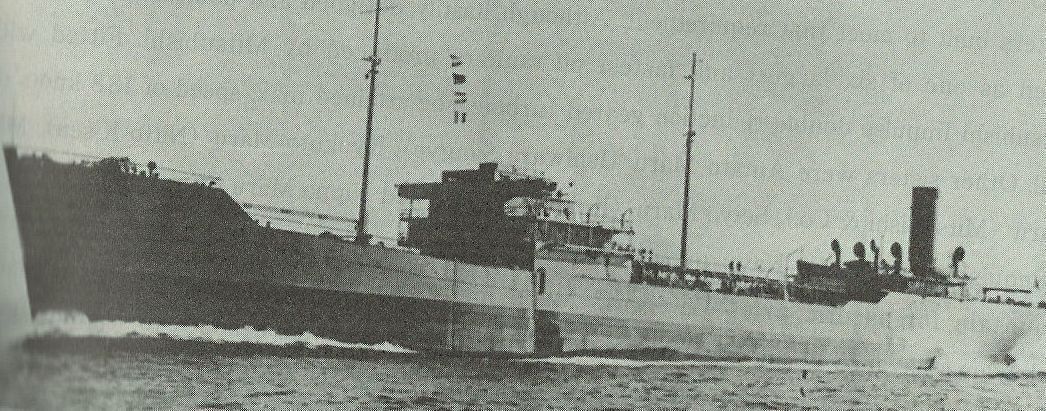YUSOSEN!
 (Wartime Standard Merchant Tanker 1TL)
(Wartime Standard Merchant Tanker 1TL)
IJN OMINESAN MARU: Tabular Record of Movement
© 2008-2020 Bob Hackett and Peter Cundall.
Revision 2
7 June 1943:
Nagasaki. Laid down by Mitsubishi Jukogyo K.K. Nagasaki Zosensho as a 10,536-ton 1TL Standard Merchant Tanker for Mitsui Sempaku.
1 October 1943:
Launched and named OMINESAN MARU. [1]
27 November 1943:
Completed and registered in Tokyo. Her Gross Registered Tonnage (GRT) and Net Registered Tonnage (NRT) respectively are 10,567-tons and 8,290-tons. Her call sign is JGBS. Requisitioned by the IJN the same day. [2]
3 December 1943:
Departs Nagasaki.
4 December 1943:
Arrives at Sasebo.
6 December 1943:
Departs Sasebo.
7 December 1943:
Arrives at an unknown Japanese port.
9 December 1943:
Departs the unknown port and later that day arrives at Moji.
11 December 1943:
OMINESAN MARU departs Moji in convoy HI-25 consisting of cargo ships JUYO, NISHI, SHOZUI and KAGU MARUs and tankers OTOWASAN, NICHINAN (5175 gt), ZUIHO and AMATSU MARUs escorted by kaibokan TSUSHIMA. [3]
15 December 1943:
Before arrival, JUYO MARU detaches for Kirun, Formosa (now Keelung, Taiwan). Later that day the rest of the convoy arrives at Takao, Formosa (now Kaoshiung, Taiwan). NISHI MARU is detached.
16 December 1943:
Departs Takao.
21 December 1943:
Arrives at Singapore.
26 December 1943:
At 1000 departs Singapore in HI-26 convoy believed to also consist of AMATSU, OTOWASAN MARUs, TAKASAKI and possibly up to three unidentified merchant ships with kaibokan TSUSHIMA as sole escort. [4]
1 January 1944:
Arrives at Takao. TSUSHIMA Detaches. Registered in the IJN under internal order No. 16 as an auxiliary oiler, (Otsu) category and attached to the Sasebo Naval District with Sasebo as homeport. Navy (Resv, unknown rank) Horigome Katsutoshi is appointed Commanding Officer.
3 January 1944:
Departs Takao with convoy increased by addition of SHINSHU, TOZAN, ARIMASAN, NOTO, MIIKE and MAYASAN MARUs with light cruiser KASHII as escort. Note that some or all of these may have joined north of Takao.
7 January 1944:
At 1830 arrives at Moji.
9 January 1944:
At Tokuyama.
20 January 1944:
At 1200, OMINESAN MARU departs Moji for Singapore in convoy HI-37 also consisting of tankers AMATSU and OTOWASAN MARUs, passenger-cargo ships MIIKE and NOTO MARUs and IJA landing craft depot ships KIBITSU and MAYASAN MARUs and an unidentified ship escorted by kaibokan MIYAKE and KANJU.
29 January 1944:
At 1200, arrives at Singapore.
2 February 1944:
At 1300, OMINESAN MARU departs Singapore in convoy HI-38 also consisting of fleet oiler ASHIZURI and tankers AMATSU, OTOWASAN, NICHINAN (5175 gt) and OKIKAWA MARUs, transports KAGU and KACHIDOKI (ex-PRESIDENT HARRISON) escorted by kaibokan KANJU.
8 February 1944:
At 1700, arrives at Takao.
9 February 1944:
At 1000, departs Takao.
13 February 1944:
At 1430, arrives at Moji.
14 February 1944:
At 0930, departs Moji. Arrives at Tokuyama later that day.
20 February 1944:
Departs Tokuyama.
21 February 1944:
At 0700, OMINESAN MARU departs Moji for Singapore in convoy HI-47 also consisting of tankers AMATSU, OTOWASAN and KYOKUHO MARUs, cargo liner NOSHIRO MARU and five unidentified merchant ships escorted by kaibokan ETOROFU and SADO.
26 February 1944:
At 0850, the convoy arrives at Takao.
27 February 1944:
At midnight, the convoy departs Takao, its number swelled by five unidentified merchants and kaibokan IKI.
28 February 1944:
Kaibokan SADO is detached from the convoy and returns to Takao
1 March 1944:
Directly attached to the Combined Fleet
4 March 1944:
South China Sea, 130 km northeast of Laut Island, Riau Archipelago, Netherlands East Indies (now Indonesia). At dawn, LtCdr (later Cdr) Charles M. Henderson's (USNA ’34) USS BLUEFISH (SS-222) attacks the convoy and hits OMINESAN MARU in the engine room with two torpedoes. She sinks by the stern in shallow water at 05-29N, 108-46E. 46 crewmen are KIA.
10 May 1944:
Removed from the Navy List under internal order No. 654.
Authors' Notes:
[1] OMINESAN MARU is frequently shown in Allied records as TAIHOSAN MARU.
[2] NRT is a ship's cargo volume capacity expressed in "register tons", one of which equals to a volume of 100 cubic feet (2.83 m3). It is calculated by subtracting non-revenue-earning spaces i.e. spaces not available for carrying cargo, for example engine rooms, fuel tanks and crew quarters, from the ship's gross register tonnage (GRT). Net register tonnage (NRT) is not a measure of the weight of the ship or its cargo, and should not be confused with terms such as deadweight tonnage or displacement.
[3] It is possible, but unlikely, that ICHIYO MARU was in this convoy rather than OMINESAN MARU.
[4] ICHIYO MARU may possibly have been in this convoy but was more likely in HI-24. Author Komamiya Shinshichiro appears to have erred in his research on this convoy. Komamiya lists ITSUKUSHIMA MARU (37, 10006 tk), OMUROSAN MARU Maru (37, 9204 tk), NANKAI MARU(33, 8416), TATEKAWA MARU(35, 10090 tk) in the convoy, but all are either erroneous or questionable and thus have been omitted from our TROM.
It appears more likely all were in convoy SA-20 that arrived Moji 1 January 1944. JACAR sources confirms an earlier arrival date of TATEKAWA MARU, so she could not have been in HI-26. Further, author Toda Gengoro's "Tokusetsu Kansen" indicates most of the others were in convoy SA-20.
Thanks to Gilbert Casse of France and Berend van der Wal of Netherlands. Thanks also go to Gengoro S. Toda of Japan.
- Bob Hackett and Peter Cundall.
Back to the Oilers Page





